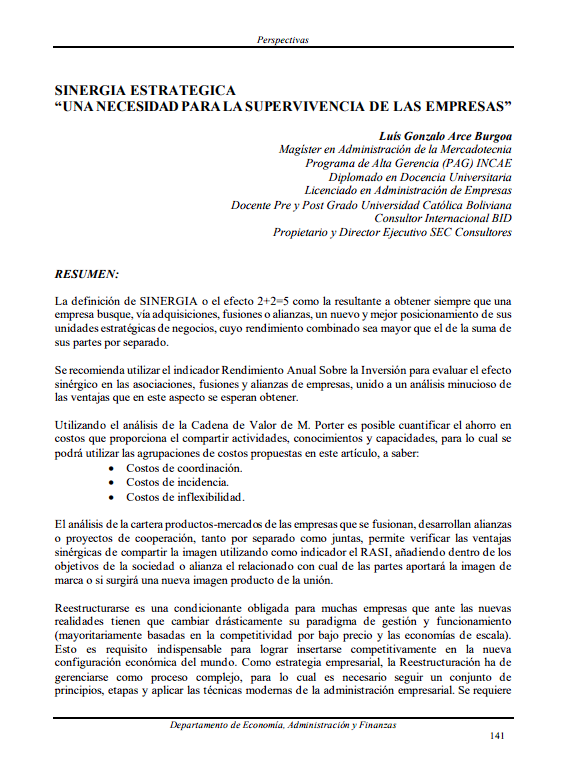Strategic synergy "A necessity for the survival of companies"
DOI:
https://doi.org/10.35319/0qjgtx40Keywords:
Synergy, Mergers and alliances, Annual Return on Investment (ROI), Value chainAbstract
Synergy, defined as the "2+2=5" effect, refers to the enhanced performance that can be achieved when strategic business units are integrated through acquisitions, mergers, or alliances. To assess this synergy effect, it is recommended to use the Annual Return on Investment (ROI), along with a thorough analysis of the expected benefits. Using Porter’s value chain analysis, cost savings can be quantified by sharing activities, knowledge, and capabilities, categorized into three types of costs: coordination, incidence, and inflexibility.
Analyzing the product-market portfolio of merging or partnering firms also reveals branding synergies, clarifying whether one party contributes its brand image or if a new identity emerges. Business restructuring becomes essential to meet today’s challenges by moving away from outdated management paradigms. This complex strategy should follow a set of principles, structured stages, and modern management techniques. Lastly, considering outsourcing and both vertical and horizontal cooperation while leveraging network economies can enhance the competitiveness of each firm individually and the broader regional and national economy.
Downloads
References
Ansoff, I. H. (1988). Synergies and capabilities profile. New Corporate Strategy.
Buzzell, R. y Gale, B. (1987). Estrategias integradoras para agrupamientos de empresas. Reproducido de The PIMS Principles. The Free Press. Reeditado en español por Deusto S.A., 1994.
Casanovas Monserrat, R. (1982). La sinergia como causa y efecto de las concentraciones empresariales. Revista Alta Dirección, junio.
Chartterjee, S. (1991). Gains in vertical acquisitions and market power: theory and evidence. Academy of Management Journal, vol. 34 (3), pp. 718-733.
D'Aveni, R. y Ravenscraft, D. (1994). Economies of integration versus bureaucracy costs: Does vertical integration improve performance?. Academy of Management Journal, vol. 37 (5), pp. 1167-1206.
Demsetz, H. (1988). The theory of the firm revisited. Journal of Law, Economics and Organization, vol. 1, pp. 141-161.
Hamel, G. y Prahalad, C. K. (1994). Competing for the Future. Cambridge, Mass.: Harvard Business School Press, p. 227.
Haspeslagh, P. y Jemison, B. D. (1991). Managing acquisitions: creating value through corporate renewal. The Free Press.
Huerta, E. (1986). Causas y efectos de la integración vertical de empresas: evidencia empírica. Economía Industrial, vol. 251, pp. 117-122.
Moss Kanter, R. (1990). Buscar y obtener sinergias. Cuando los gigantes aprenden a bailar. Barcelona.
Prahalad, C. K. y Doz, L. (1986). Evaluación de la interdependencia entre empresas. Reproducido de The Free Press. Publicado en español por Deusto S.A., 1994.
Porter, M. (1985). Las interrelaciones entre las unidades empresariales. Reproducido de Competitive Advantage: Creating and Superior Performance. The Free Press. Publicado por Deusto S.A., 1994.
Quinn, J. B., Doorley, T. L. y Paquette, P. C. (1990). Technology in services: Rethinking strategic focus. Sloan Management Review, invierno, pp. 79-87.
Quinn, J. B. (1992). Leveraging knowledge and service-based strategies through outsourcing. En Intelligent Enterprise. Free Press, Nueva York, pp. 71-97.
Quinn, J. B. y Hilmer (1995). Strategic Outsourcing. The McKinsey Quarterly, número 1.
The Boston Consulting Group, Inc. (1970). The Product Portfolio. Perspectives, No. 66.
Weitz, John, G. (1988). Forward integration into distribution. An empirical test of transaction cost analysis. Journal of Law, Economics and Organization, vol. 4, pp. 337-355.

Downloads
Published
Issue
Section
License
Copyright (c) 2008 Revista Perspectivas

This work is licensed under a Creative Commons Attribution-NonCommercial-ShareAlike 4.0 International License.
La Revista Perspectivas de la Universidad Católica Boliviana, es una revista de acceso abierto, por lo tanto, es de libre acceso en su integridad. Está permitida su lectura, búsqueda, descarga, distribución y reutilización legal en cualquier tipo de soporte únicamente para fines no comerciales, siempre y cuando la obra sea debidamente citada.




